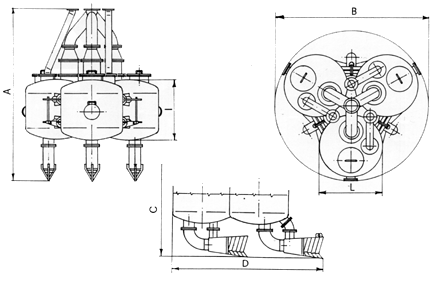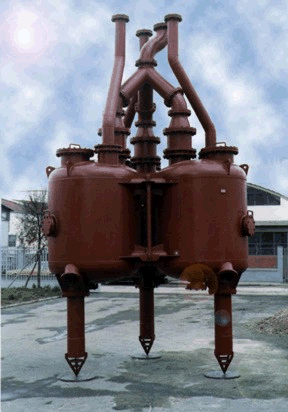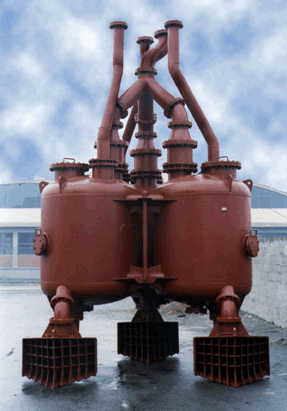![]()
![]()
The plant is formed by:
a) Pump body, generally consisting of 3 cylinders with no internal rotating mechanisms apart from rubber inlet and delivery valves. The pump can be equipped with inlet pipes (see fig. 1) or with. disaggregating and levelling shovels (see fig. 2).
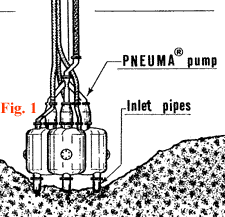
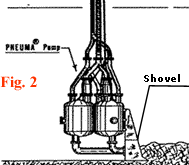
b) Distributor, which
regulates the influx and discharge of compressed air to and from each
cylinder of the pump body and assures uniform functioning and a continuous
flow.
c) A supply of air,
generally produced by a compressor
driven by any type of motor.
The compressor and distributor group are placed on the surface, even at a
considerable distance from the pump body to which they are connected by compressed
air hoses. In case of deep waters the distributor is placed on the top of
the pump body.
The delivery and air hoses
are completely independent from the rest of the plant.
The liquid fills the cylinder by the counter-pressure due to the level of
the liquid itself or by a vacuum system utilised in very shallow waters.
Once the cylinder is full, compressed air, supplied by the distributor, acts
as a piston.
Consequently the liquid tends to close the external valve and pass through
the internal delivery valve.
After having worked in one cylinder, the compressed air is discharged through
the distributor into the atmosphere.
The regulation of the distributor movements which automatically put the pump
body valves into operation through the air pressure and the counterpressure
of the liquid, guarantees the perfect uniformity of the flow.
![]()
The
PNEUMA pumps, working due to the effect of the hydrostatic water column or
of a vacuum system in case of shallow waters, can be considered a positive
displacement piston pump, with compressed air taking place of a mechanical
piston
.
The
work cycle of the Pneuma pumps can be divided into three phases:
Each cylinder is rapidly filled with mixture by the counter pressure due to
the hydrostatic head with the help of a vacuum system in case of shallow waters. When
the cylinder has been filled, compressed air, supplied by a compressor
through the distributor and air hose, acts as a piston and the mixture
is thus forced out through the delivery valve.
Grouped
assembly Frontal
assembly in line
Phase
one: Filling the pump
As soon as one cylinder is filled, the inlet valve automatically closes by
its own weight.
Phase
two: Emptying the pump and reflowing
Phase
three: Discharging
compressed air and preparation for Phase one
When the cylinder has been almost emptied, the distributor discharges the
air into the atmosphere. Once the internal pressure is released, the
cylinder once again becomes filled with mixture, as described in phase one.
![]()
